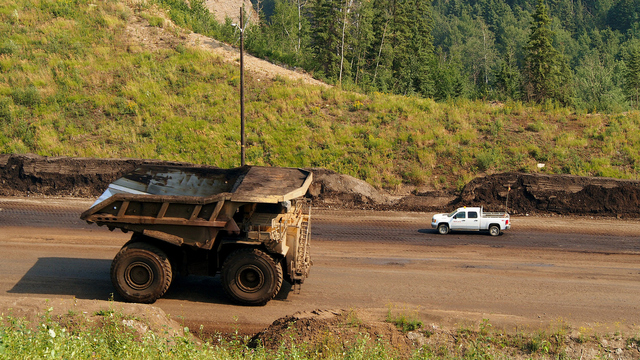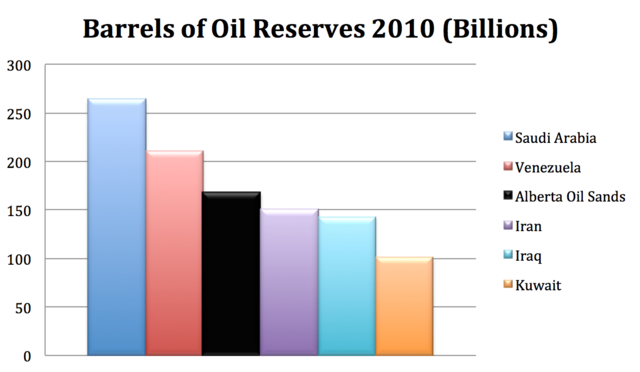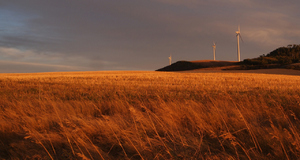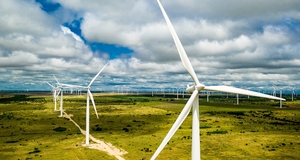The majority of oil extracted from the Alberta oil sands is processed, diluted, and then sold to the US. The implications that arise from the oil sands production are a litany of health, environmental, and economic concerns. Despite all the implications associated with the oil sands, the provincial and federal governments have continued to support further industrial expansion of this kind.
This briefing paper focuses on the issues associated with the oil sands and why it is essential to pursue new policies that further encourage renewable energy development in Canada. I will demonstrate the method by which the government could build a progressive strategy towards green energy growth. Green energy development is beneficial for Canada and its people, as it is based on long-term goals and sustainable energy policies.
The Alberta oil sands development is a pressing subject at this time. Currently, the federal government and the oil industry are pushing for the Keystone pipeline that would join the oil sands to the more lucrative markets. The Keystone pipeline has been rejected by many spheres of society, including opposition parties, environmentalists, foreign governments, and scientists. To make the situation more challenging, oil sand growth is expected to expand into the future.

Photo: Wilson Hui CC-2
An important pipeline, called the Keystone Export Limited (XL) pipeline, connecting Alberta oil sands to refineries on the Texas gulf cost would hasten this process. It is estimated that between 2010 and 2025, more than $379 billion will be invested in oil sands development. As a result, oil production is expected to more than double, to roughly 3.7 million barrels a day by 2021. With the current debate surrounding the oil sands, this doubling of production will have major implications for Canada and the world. Based on a thorough analysis, I will demonstrate that further oil sands development is potentially devastating to the Canadian wilderness, its waterways, and its inhabitants.
Secondly, expansion of the oil sands is risky economics for the Canadian economy and private companies. Thirdly, support for oil sands by the government is politically hazardous, since it demonstrates near-sightedness, contempt for science and the environment, and a lack of concern for the livelihood of populations living in the vicinity.
The Alberta oil sands are enormous oil reserves that cover roughly 140,000 square kilometers, or 20% of Alberta’s surface area. This space, which is slightly larger than the surface area of England, rests under the second largest boreal forest in the world. Boreal forests are recognized as vital components of the natural ecosystem and important carbon capture systems. These forests are home to diverse wildlife, pristine waterways, and over one hundred thousands people. The oil in these sands is extracted by two methods, either by surface mining or in-situ mining. The ecological footprint left behind by both extraction methods is astonishing.
The oil sands produce around 1.6 million barrels of oil per day. The extraction process is extremely energy intensive, and requires approximately 30% more energy input than conventional extraction. The CO2 emissions are also much higher than conventional extraction and can be measured by a system called “well to wheel,” which measures the total CO2 released in extraction, refinement, transport, and the final ignition of the fuel. According to a report by the World Wildlife Federation & The Co-operative Bank Insurance Investments, producing oil from oil sands creates, on average, three times more greenhouse gas emissions (GHG) than conventional oil.
A recent estimate put the oil sands industry alone as responsible for 41.9metric tons of CO2, equivalent to 6.5% of Canada’s total emissions and 0.1% of the global greenhouse gas. If the province of Alberta, home of the oil sands, were a country, it would have the highest per capita emissions in the world.
Locally, the problems become more acute. On average, for every barrel of oil produced, the consumption rate of clean water is 3 to 4.5 barrels, and this takes into account the recycling process. This toxic water is then dumped into “tailing ponds” until reclamation can take place. After nearly 4.5 decades of operation, there is no evidence that reclamation of tailing ponds is possible.
This is of particular concern to Canadians, especially those that live near the lakes, and rivers, affected by oil sands processing. According to Canadian scientist, and oil sands expert, David Schindler, there is without a doubt leakage from tail ponds into the water table in northern Alberta. It is for these reasons and a host of further problematic issues, that according to Pulitzer Prize winning author and energy expert Daniel Yergin, “Canada’s tar sands are the world’s most expensive major source of oil in the world.”
At an estimated 170 billion barrels of recoverable oil, the Alberta oil sands are the third largest proven oil reserves in the world. According to NASA scientist James Hansen, “if Canada proceeds with oil sands development and nothing is done, it will be game over for climate.” The federal government has adamantly denied these claims and has maintained steadfast support for further oil sands development. Resource Minister Tony Clement publicly dismissed Hansen’s comments as nonsense. However, as demonstrated in figure 1 below, Hansen was simply crunching the numbers.
According to the International Energy Agency, approximately 1.1 trillion (1100 million) barrels of oil have been extracted in the last 150 years, or since the first oil well was operational. Since then, a tremendous amount of CO2 has been released into the atmosphere as result of this oil use. If we imagine that all of the oil sands were developed with 3 times the conventional CO2 release, we get a frightening scenario. The amount of CO2 released from the oil sands alone would be more than 45% of all CO2 emissions that have previously been released into the atmosphere from oil consumption in the last 150 years. This does not even take into account the effects on Canada’s wilderness, waterways, and people.
Figure 1: 1,100 billion barrels produced since 1856

Continued on Next Page »
Al Jazeera witness. Available at: http://www.youtube.com/watch?v=nQrWZzBOCoc/ [Assessed on 02/05/2013].
Alberta Oil Sands Industry Quarterly Update. (2013) reporting on the period: Jan. 18, 2013, to Mar. 14. Available at: http://www.albertacanada.com/files/albertacanada/AOSID_QuarterlyUpdate_Spring2013.pdf/ [Assessed on: 19/04/2013].
Alok, J. (2010). Sun, wind and wave-powered: Europe unites to build renewable energy supergrid. The Guardian, 03 January. Available at: http://www.guardian.co.uk/environment/2010/jan/03/european-unites-renewable-energy-supergrid/ [Assessed on: 05/05/2013].
American Wind Energy Association. (2008). 20% wind energy by 2030: Increasing Wind Energy’sContribution toU.S electricitysupply. Available at: http://www.nrel.gov/docs/fy08osti/41869.pdf/ [Assessed on 05/05/2013].
Chana, G. Reilly, J. Paltsev, Chenbn, H. (2012). The Canadian oil sands industry under carbon constraints. Energy Policy 50 540–550.
Climate leadership, economic prosperity (2009). Pembina Institute and David Suzuki Foundation. Available at: http://davidsuzuki.org/publications/reports/2009/climate-leadership-economic-prosperity/ [Assessed on 05/05/2013].
David Suzuki Foundation. Available at: http://www.davidsuzuki.org/blogs/climate-blog/2009/12/a-first-day-fossil-for-canada/ [Assessed on 05/05/2013].
Davidson, D. & Andrews, J. (2013). Not All About Consumption. Science AAAS. 339, pp1286-1287.
Economic Impacts of New Oil Sands Projects in Alberta (2010-2035). May 2011. Canadian Energy Research Institute. Study No. 124. Available at: http://www.api.org/aboutoilgas/oilsands/upload/economic_impacts_of_new_oil_sands_projects_alberta.pdf/ [Assessed on 02/05/2013].
Encyclopedia of nations: http://www.nationsencyclopedia.com/economies/Europe/United-Kingdom.html/
European Commission. Climate Action. http://ec.europa.eu/clima/policies/package/index_en.htm
Government of Alberta; Oil Sands Royalties, (2010-2011) Available at: http://www.oilsands.alberta.ca/economicinvestment.html/ [Assessed on 19/04/2013]
Government of Alberta. Alberta Energy, Facts and Statistics. Available at: http://www.energy.alberta.ca/oilsands/791.asp/ [Assessed on: 04/05/2013].
Government of Canada, (2011). Oil Sands; A strategic resource for Canada, North America and the global market. Available at: http://www.nrcan.gc.ca/energy/sites/www.nrcan.gc.ca.energy/files/files/OilSands-EnergySecurityEconomicBenefits_e.pdf/ [Assessed on: 19/04/2013].
International Energy Agency (IEA) and Energy Technology Systems Analysis Programme (ETSAP). (2010). Technology Brief. Available at: http://www.iea-etsap.org/web/E-TechDS/PDF/P02-Uncon%20oil&gas-GS-gct.pdf/ [Assessed on 04/05/2013].
Joe Oliver slams scientist's oilsands claims as 'nonsense'. (2013). CBC News. 24 April. Available at: http://www.cbc.ca/news/politics/story/2013/04/24/joe-oliver-keystone-pipeline-hassen.html?ref=rss/ [Assessed on 29/04/2013].
Jordaan, S. (2012) Land and Water Impacts of Oil Sands Production in Alberta Environmental Science and Technology, 46, 3611−3617.
Jordaan, S. M.; Keith, D. W.; Stelfox, B. (2009). Quantifying land use of oil sands production: A life cycle perspective. Environmental Research Letters, 4 024004.
Kelly, E. N.; Schindler, D. W.; Hodson, P. V.; Short, J. W.; Radmanovich, R.; Nielson, C. C. (2010) Oil sands development contributes elements toxic at low concentrations to the Athabasca and its tributaries. Proceedings of the National Academy of Science. 2010, 107:16178−16183.
Kelly, E., Short, J., Schindler, D., Hodson, P., Maaf, M., Kwana, A., and Fortin, B., (2009). Oil sands development contributes polycyclic aromatic compounds to the Athabasca River and its tributaries. National Academy of Sciences. 106 (52), pp. 22346-22351.
Kennedy, M. (2011). Canada pulling out of Kyoto accord. The National Post. 12 December. Available at: http://news.nationalpost.com/2011/12/12/canada-formally-withdrawig-from-kyoto-protocol/ [Assessed on 05/05/2013].
Kureka, J., Kirkb, J., Derek, G., Wangb, X., Marlene S. Evansc, & Smola, J. (2013). Legacy of a half century of Athabasca oil sands development recorded by lake ecosystems. PNAS, 110(5), pp. 1761–1766.
National Energy Board, (2011). Canada’s Energy Future: Energy supply and demand projects to 2035. Available at: http://www.neb-one.gc.ca/clf-nsi/rnrgynfmtn/nrgyrprt/nrgyftr/2011/nrgsppldmndprjctn2035-eng.pdf [Assessed on 19/04/2013].
Parks, N. (2010). Oil sands debate heats up in Alberta. Frontiers in Ecology and the Environment, 8(9), pp. 452.
Pembina Institute. Oil Sands. Available at: http://www.pembina.org/oil-sands/os101/alberta/ [Assessed on: 02/05/2013].
Price, M. (2013). Canadian Jobs lost to the tar sands. Huffington Post, May 1 2013. Available at http://www.huffingtonpost.ca/matt-price/canadian-oil_b_1180255.html/ [Assessed on: 02/05/2013].
Renewable Energy World. (2010) Available at: http://www.renewableenergyworld.com/rea/news/article/2010/01/samsung-invests-can-7b-in-ontario-wind-and-solar/ [Assessed on 05/05/2013].
Rubin, J. (2013). Globe and Mail. How big is Canada’s oil subsidy to the U.S.? 7 January 2013, Available at: http://www.theglobeandmail.com/report-on-business/industry-news/energy-and-resources/how-big-is-canadas-oil-subsidy-to-the-us/article6994747/ [Assessed on 26/04/2013].
Statistics Canada. (2011) Population and dwelling counts; Population breakdown of northern Alberta. Available at: http://www12.statcan.gc.ca/census-recensement/2011/dp-pd/hlt-fst/index.cfm?Lang=E/ [Assessed on 02/05/2013].
The Impacts of Canadian Oil Sands Development on the United States’ Economy. (2009) Canadian Energy Research Institute. October 2009. Available at: http://www.scribd.com/doc/21296235/CERI-The-Impacts-of-Canadian-Oil-Sands-Development-on-the-United-States%E2%80%99-Economy/ [Assessed on 05/05/2013].
Ulrike, L., Lutz, C., & Edler, D. (2012). Green jobs? Economic impacts of renewable energy in Germany. Energy Policy, 47, pp 358–364.
UNDP (2008). Human Development Report 2007/08 p145, available at: http://hdr.undp.org/en/media/HDR_20072008_EN_Complete.pdf/ [Assessed on 19/04/2013].
Weinhold, B. (2011). Alberta’s Oil Sands Hard Evidence, Missing Data, New Promises. Environmental Health Perspectives. 119(3), pp 126-131.
Wells, P. & McMahon, T. (2012). How Ottawa runs on oil; Suddenly western money and influence are driving everything that happens in the nation’s capital. Macleans, 23 March. Available from: http://www2.macleans.ca/2012/03/23/oil-power/ [Assessed April 15 2013].
World Energy Outlook (2008). International Energy Agency. Available at: http://www.worldenergyoutlook.org/media/weowebsite/2008-1994/weo2008.pdf/ [Assessed on 29/04/2013].
Wustenhagen, R. & Bilharz, M. (2006). Green energy market development in Germany: effective public policy and emerging customer demand. Energy Policy 34, pp 1681–1696.
WWF & The Co-operative Bank Insurance Investments (2008). Unconventional Oil; Scraping the bottom of the barrel. World Wildlife Federation report: Available at: http://wwf.panda.org/?unewsid=142161#/ [Assessed on 02/02/2013].
Yergin, D. & Burkhard, J. (2008). Break Point Revisited: CERA's $120-$150 Oil Scenario. IHS CERA. Available at: http://www.ihs.com/products/cera/energy-report.aspx?id=106591829/ [Assessed on: 19/04/2013].
Yergin, D., Burkhard, J., & Kadakia, R. (2008) Ratcheting Down: Oil and the Global Credit Crisis. HIS CERA. Available at: http://www.ihs.com/products/cera/energy-report.aspx?ID=106591844&pu=1&rd=cera_com/ [Assessed on: 19/04/2013].
Endnotes
1.) The Impacts of Canadian Oil Sands Development on the United States’ Economy. (2009) Canadian Energy Research Institute. Pp. vii.
2.) Government of Alberta. Alberta Energy, Facts and Statistics. Available at: http://www.energy.alberta.ca/oilsands/791.asp/ [Assessed on: 04/05/2013].
3.) Jordaan, S. M.; Keith, D. W.; Stelfox, B. (2009). Quantifying land use of oil sands production: A life cycle perspective. Environmental Research Letters, 4 024004.
4.) Encyclopedia of nations: Available at: http://www.nationsencyclopedia.com/economies/Europe/United-Kingdom.html/
5.) Statistics Canada. (2011) Population and dwelling counts; Population breakdown of northern Alberta. Available at: http://www12.statcan.gc.ca/census-recensement/2011/dp-pd/hlt-fst/index.cfm?Lang=E/
6.) Government of Alberta. Alberta Energy, Oil Sands. Available at: http://www.energy.alberta.ca/ourbusiness/oilsands.asp.
7.) International Energy Agency (IEA) and Energy Technology Systems Analysis Programme (ETSAP) May 2010. Technology Brief. Available at: http://www.iea-etsap.org/web/E-TechDS/PDF/P02-Uncon%20oil&gas-GS-gct.pdf/
8.) WWF & The Co-operative Bank Insurance Investments (2008). Unconventional Oil; Scraping the bottom of the barrel. P21. Available at: http://wwf.panda.org/?unewsid=142161#/
9.) Chana, G. Reilly, J. Paltsev, Chenbn, H. (2012). The Canadian oil sands industry under carbon constraints. Energy Policy 50, p541.
10.) Alberta’s total greenhouse gas emissions in 2008 were 244 megatonnes of CO2 equivalent. (Environment Canada, “National Inventory Report -Part 3 1990-2008 Greenhouse Gas Sources and Sinks in Canada”) Alberta’s population in 2008 was estimated to be 3.51 million people. (Alberta Finance, Alberta Population Report, 2008).
11.) Government of Alberta. 2013. Alberta Energy: Facts and Statistics. http://www.energy.alberta.ca/OilSands/791.asp
12.) WWF & The Co-operative Bank Insurance Investments (2008). Unconventional Oil; Scraping the bottom of the barrel. World Wildlife Federation report. p31
13.) Al Jazeera witness. Available at: http://www.youtube.com/watch?v=nQrWZzBOCoc/
14.) Yergin, D., Burkhard, J., & Kadakia, R. (2008) Ratcheting Down: Oil and the Global Credit Crisis. HIS CERA. Available at: http://www.ihs.com/products/cera/energy-report.aspx?ID=106591844&pu=1&rd=cera_com/
15.) Government of Alberta. 2013. Alberta Energy: Facts and Statistics .http://www.energy.alberta.ca/oilsands/791.asp
16.) Joe Oliver slams scientist's oilsands claims as 'nonsense'. (2013). CBC News. 24 April. Available at: http://www.cbc.ca/news/politics/story/2013/04/24/joe-oliver-keystone-pipeline-hassen.html?ref=rss/
17.) World Energy Outlook (2008). International Energy Agency. Pp198. Available at: http://www.worldenergyoutlook.org/media/weowebsite/2008-1994/weo2008.pdf/
18.) 1100 billion barrels of oil used to date (World Energy Outlook) & 170 billion barrels in Oil Sands multiplied by 3 (Oil sands releases 3 times the CO2 emissions) = CO2 emission from 510 billion barrels of oil. (changed to a %, 510/1100 = 45%)
19.) Government of Canada, (2011). Oil Sands; A strategic resource for Canada, North America and the global market. Available at: http://www.nrcan.gc.ca/energy/sites/www.nrcan.gc.ca.energy/files/files/OilSands-EnergySecurityEconomicBenefits_e.pdf/
20.) National Energy Board, (2011). Canada’s Energy Future: Energy supply and demand projects to 2035. Available at: http://www.neb-one.gc.ca/clf-nsi/rnrgynfmtn/nrgyrprt/nrgyftr/2011/nrgsppldmndprjctn2035-eng.pdf/
21.) Yergin, D. & Burkhard, J. (2008). Break Point Revisited: CERA's $120-$150 Oil Scenario. IHS CERA. Available at: http://www.ihs.com/products/cera/energy-report.aspx?id=106591829/
22.) 1.6 million barrels a day (Alberta Government: http://www.energy.alberta.ca/ourbusiness/oilsands.asp) divided by 89 million barrels of global production per day International Energy Agency: http://www.iea.org/aboutus/faqs/oil/
23.) CIA Fact book (2011 Figures). Country Comparison: Crude Oil - Production (translated into a percentage). Oil Sands figure based on 1.6 million barrels a day. (Alberta Government)
24.) Parks, N. (2010). Oil sands debate heats up in Alberta. Frontiers in Ecology and the Environment, 8(9), pp. 452.
25.) Ibid. pp 452.
26.) See: Kelly, E., Short, J., Schindler, D., Hodson, P., Maaf, M., Kwana, A., and Fortin, B., (2009). Oil sands development contributes polycyclic aromatic compounds to the Athabasca River and its tributaries. National Academy of Sciences. 106 (52), pp. 22346-22351 & Kureka, J., Kirkb, J., Derek, G., Wangb, X., Marlene S. Evansc, & Smola, J. (2013). Legacy of a half century of Athabasca oil sands development recorded by lake ecosystems. PNAS, 110(5), pp. 1761–1766.
27.) Parks, N. (2010). Oil sands debate heats up in Alberta. Frontiers in Ecology and the Environment, 8(9), pp. 452.
28.) Canadian GDP 1,762,432 million (Statistics Canada (2011). divided by 37,000 million (Government of Alberta; Oil Sands Royalties, (2010-2011) = 2%
29.) Economic Impacts of New Oil Sands Projects in Alberta (2010-2035). May 2011. Canadian Energy Research Institute. Study No. 124. Pp9 Available at: http://www.api.org/aboutoilgas/oilsands/upload/economic_impacts_of_new_oil_sands_projects_alberta.pdf/
30.) 144,000 thousand gross employment (Government of Alberta: http://www.oilsands.alberta.ca/economicinvestment.html) divided by Canadian working population 17.5 million in 2012 (Statistics Canada)
31.) Price, M. (2013). Canadian jobs lost to the tar sands. Huffington Post, May 1 2013. Available at:http://www.huffingtonpost.ca/matt-price/canadian-oil_b_1180255.html/
32.) Ibid.
33.) The Impacts of Canadian Oil Sands Development on the United States’ Economy. (2009) Canadian Energy Research Institute. Pp. vii.
34.) American Wind Energy Association. (2008). 20% wind energy by 2030: Increasing WindEnergy’scontribution toU.S electricitysupply. Available at: http://www.nrel.gov/docs/fy08osti/41869.pdf/
35.) Alok, J. (2010). Sun, wind and wave-powered: Europe unites to build renewable energy supergrid. The Guardian, 03 January. Available at: http://www.guardian.co.uk/environment/2010/jan/03/european-unites-renewable-energy-supergrid/
36.) CBC News (2011). Available at: http://www.cbc.ca/news/politics/story/2011/12/12/pol-kent-kyoto-pullout.html/
37.) CBC News (2011). Available at: http://www.cbc.ca/news/canada/story/2013/03/27/un-droughts-deserts-convention-canada.html
38.) CBC News ( 2009) Canada tagged as fossil of the year. Available at: http://www.cbc.ca/news/world/story/2009/12/18/climate-canada-award.html
39.) European Commission. Climate Action. Available at: http://ec.europa.eu/clima/policies/package/index_en.htm
40.) Ulrike, L., Lutz, C., & Edler, D. (2012). Green jobs? Economic impacts of renewable energy in Germany. Energy Policy, 47, pp358
41.) Wustenhagen, R. & Bilharz, M. (2006). Green energy market development in Germany: effective public policy and emerging customer demand. Energy Policy 34, pp 1681–1696.
42.) Climate leadership, economic prosperity (2009). Pembina Institute and David Suzuki Foundation. Pp12. Available at: http://davidsuzuki.org/publications/reports/2009/climate-leadership-economic-prosperity/
43.) Renewable Energy World. (2010) Available at: http://www.renewableenergyworld.com/rea/news/article/2010/01/samsung-invests-can-7b-in-ontario-wind-and-solar/





















